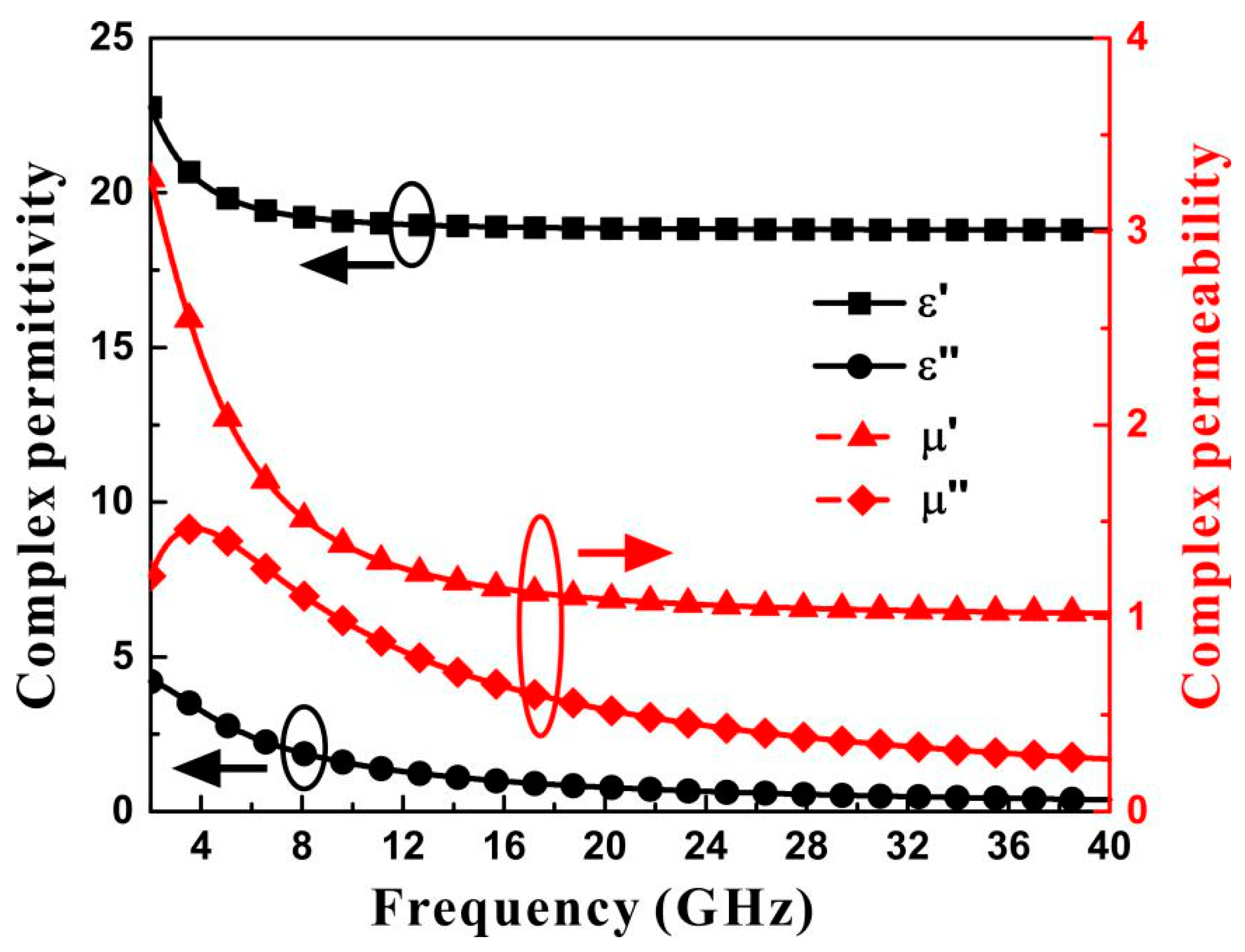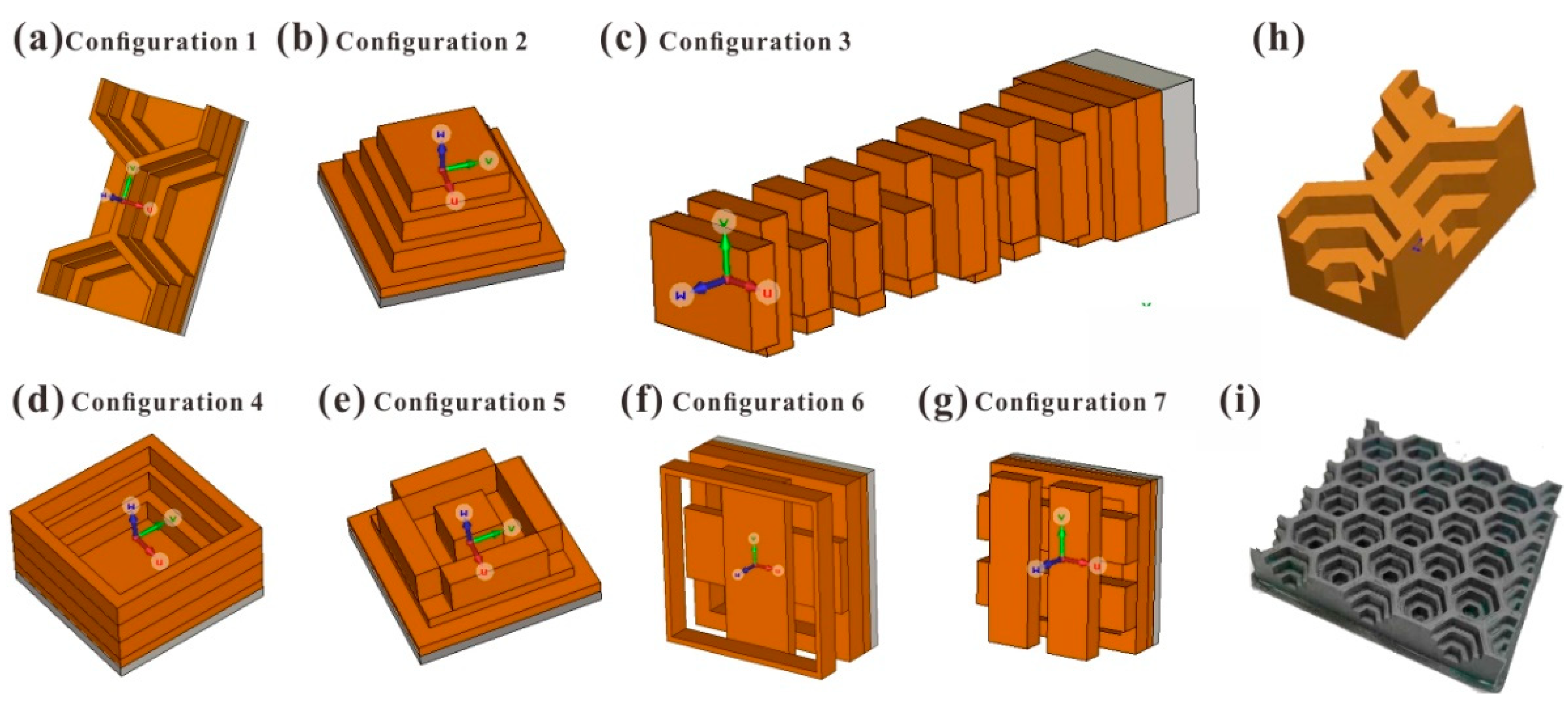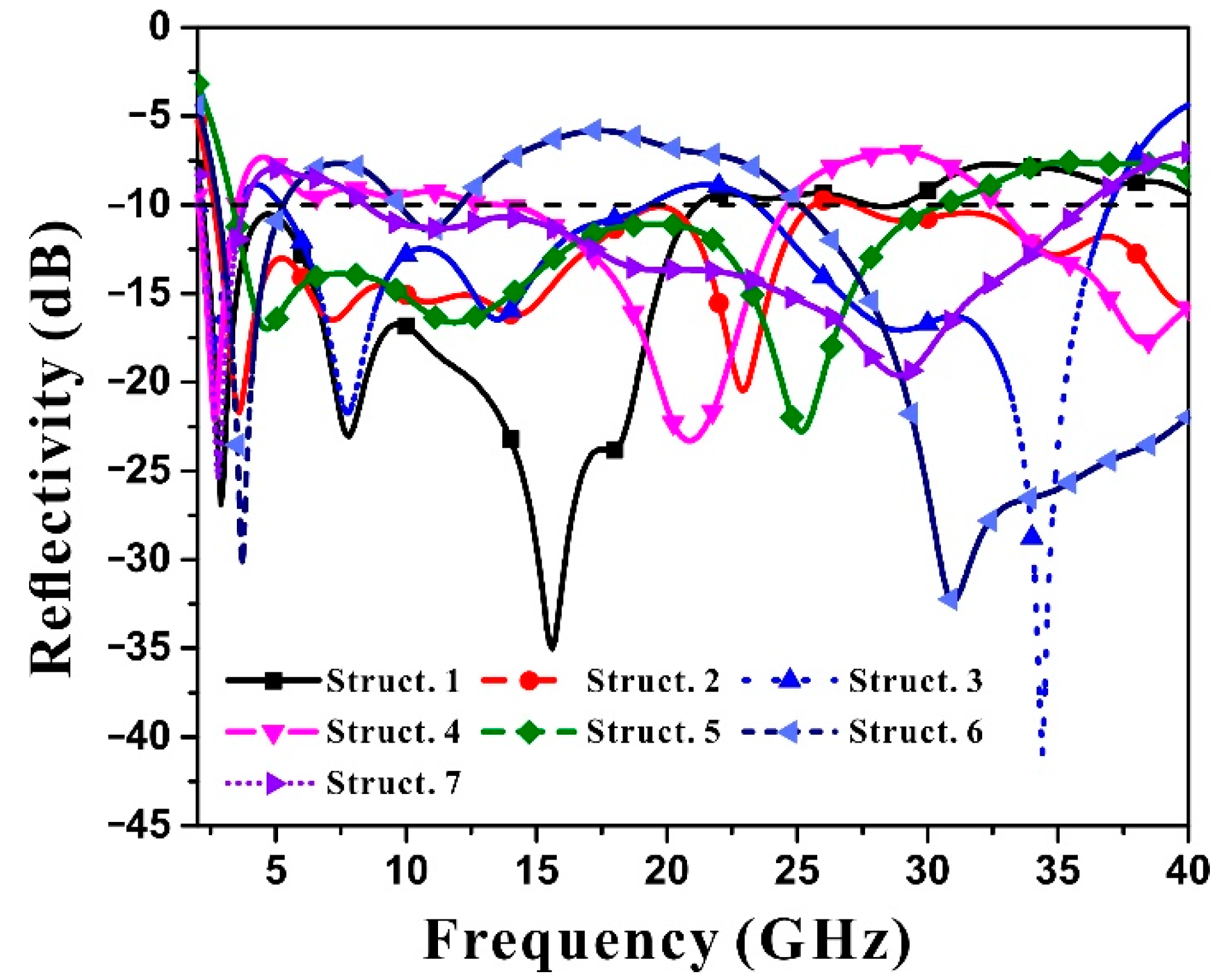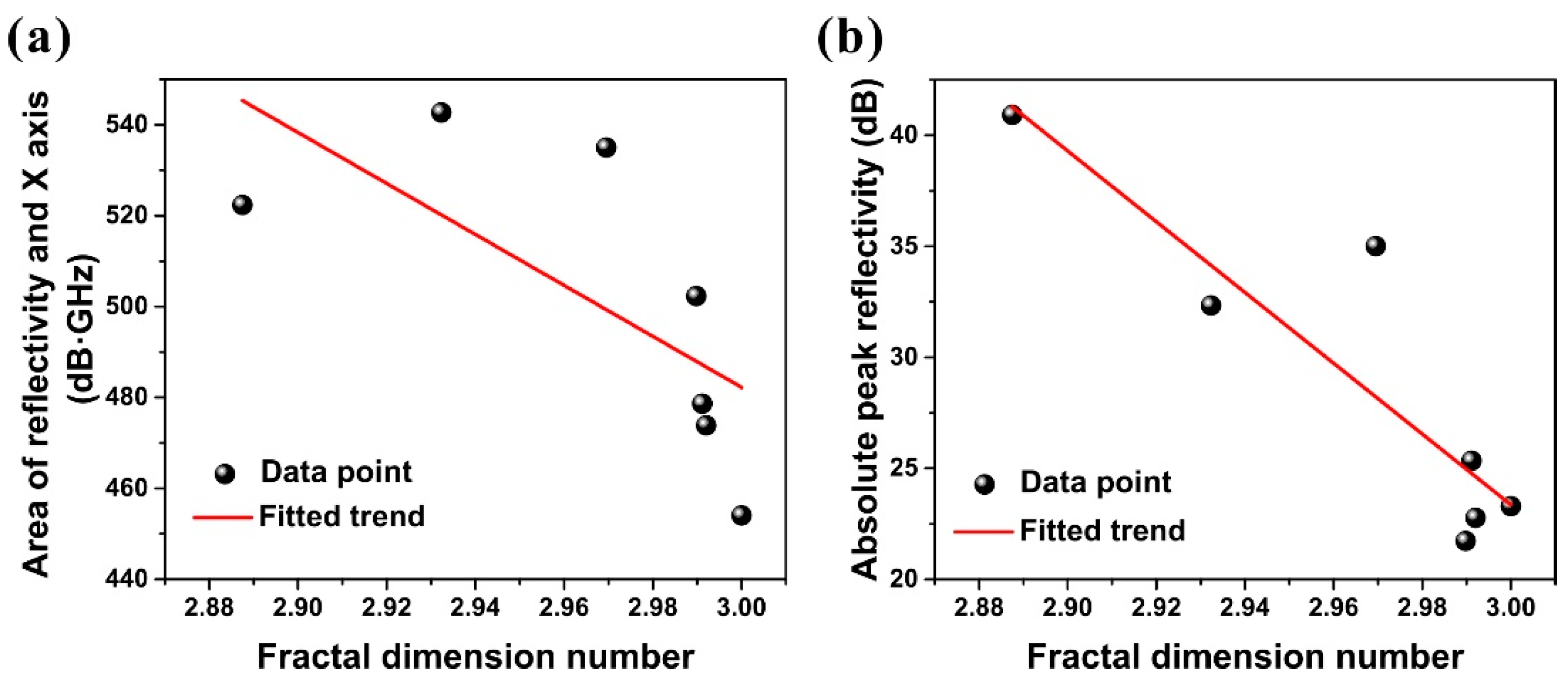Broadband Electromagnetic Absorption Effect of Topological Structure Using Carbon Nanotube Based Hybrid Material
Abstract
:1. Introduction
2. Materials and Methods
2.1. Material and Characterization
2.2. Simulation Method and Analysis Model
2.3. Calculation of Fractal Dimension Number
3. Results and Discussion
3.1. Experimental Verification
3.2. Reflectivity Calculation and Analysis
3.3. Fractal Dimension Numbers of Seven Typical Configurations
3.4. Correlation between Fractal Dimension and Electromagnetic Loss
4. Conclusions
Author Contributions
Funding
Institutional Review Board Statement
Informed Consent Statement
Data Availability Statement
Conflicts of Interest
References
- Luo, H.; Chen, F.; Wang, X.; Dai, W.; Xiong, Y.; Yang, J.; Gong, R. A novel two-layer honeycomb sandwich structure absorber with high-performance microwave absorption. Compos. Part A-Appl. Sci. Manuf. 2019, 119, 1–7. [Google Scholar] [CrossRef]
- Zhong, B.; Liu, W.; Yu, Y.; Xia, L.; Zhang, J.; Chai, Z.; Wen, G. Enhanced microwave absorption properties of graphite nanoflakes by coating hexagonal boron nitride nanocrystals. Appl. Surf. Sci. 2017, 420, 858–867. [Google Scholar] [CrossRef] [Green Version]
- Song, W.L.; Zhang, K.L.; Chen, M.; Hou, Z.L.; Chen, H.; Yuan, X.; Ma, Y.; Fang, D. A universal permittivity-attenuation evaluation diagram for accelerating design of dielectric-based microwave absorption materials: A case of graphene-based composites. Carbon 2017, 118, 86–97. [Google Scholar] [CrossRef]
- Liu, B.; Li, J.; Wang, L.; Ren, J.; Xu, Y. Ultralight graphene aerogel enhanced with transformed micro-structure led by polypyrrole nano-rods and its improved microwave absorption properties. Compos. Part A-Appl. Sci. Manuf. 2017, 97, 141–150. [Google Scholar] [CrossRef]
- Dosoudil, R.; Usakova, M.; Franek, J.; Slama, J.; Gruskova, A. Particle size and concentration effect on permeability and EM-wave absorption properties of hybrid ferrite polymer composites. IEEE Trans. Magn. 2010, 46, 436–439. [Google Scholar] [CrossRef]
- Zong, M.; Huang, Y.; Wu, H.; Zhao, Y.; Wang, Q.; Sun, X. One-pot hydrothermal synthesis of RGO/CoFe2O4 composite and its excellent microwave absorption properties. Mater. Lett. 2014, 114, 52–55. [Google Scholar] [CrossRef]
- Saravanakumar, B.; Rani, B.J.; Ravi, G.; Thambidurai, M.; Yuvakkumar, R. Reducing agent (NaBH4) dependent structure, morphology and magnetic properties of nickel ferrite (NiFe2O4) nanorods. J. Magn. Magn. Mater. 2017, 428, 78–85. [Google Scholar] [CrossRef]
- Tang, J.; Jia, S.; Zhang, S.; Ping, F. Progress of rGO-based microwave absorbing material. New Chem. Mater. 2021, 49, 5–8. [Google Scholar]
- Landy, N.I.; Sajuyigbe, S.; Mock, J.J.; Smith, D.R.; Padilla, W.J. Perfect metamaterial absorber. Phys. Rev. Lett. 2008, 100, 207402. [Google Scholar] [CrossRef]
- McCall, M. Transformation optics and cloaking. Contemp. Phys. 2013, 54, 273–286. [Google Scholar] [CrossRef]
- Berry, M.V. Nature’s optics and our understanding of light. Contemp. Phys. 2015, 56, 2–16. [Google Scholar]
- Babaee, S.; Shim, J.; Weaver, J.C.; Chen, E.R.; Patel, N.; Bertoldi, K. 3D Soft Metamaterials with Negative Poisson’s Ratio. Adv. Mater. 2013, 25, 5044–5049. [Google Scholar] [CrossRef] [PubMed]
- Wang, B.X.; Wang, L.L.; Wang, G.Z.; Huang, W.Q.; Zhai, X.; Li, X.F. Tunable bandwidth of the terahertz metamaterial absorber. Opt. Commun. 2014, 325, 78–83. [Google Scholar] [CrossRef]
- Li, L.Y.; Wang, J.; Du, H.L.; Wang, J.F.; Qu, S.B. Achieving a multi-band metamaterial perfect absorber via a hexagonal ring dielectric resonator. Chin. Phys. B 2015, 4, 064201. [Google Scholar] [CrossRef]
- Agarwal, S.; Prajapati, Y.K.; Singh, V.; Saini, J.P. Polarization independent broadband metamaterial absorber based on tapered helical structure. Opt. Commun. 2015, 356, 565–570. [Google Scholar] [CrossRef]
- Khurram, A.A.; Raza, M.A.; Zhou, P.; Subhani, T. A study of the nanocomposite sandwich structures for broadband microwave absorption and flexural strength. J. Sandw. Struct. Mater. 2016, 18, 739–753. [Google Scholar] [CrossRef]
- Yuchang, Q.; Jie, W.; Hongyu, W.; Fa, L.; Wancheng, Z. Graphene nanosheets/E-glass/epoxy composites with enhanced mechanical and electromagnetic performance. RSC Adv. 2016, 6, 80424–80430. [Google Scholar] [CrossRef]
- Luo, Y.; Fan, H. Energy absorbing ability of rectangular self-similar multi-cell sandwich-walled tubular structures. Thin-Walled Struct. 2018, 124, 88–97. [Google Scholar] [CrossRef]
- Huang, Y.; Yuan, X.; Chen, M.; Song, W.L.; Chen, J.; Fan, Q.; Tang, L.; Fang, D. Ultrathin Flexible Carbon Fiber Reinforced Hierarchical Metastructure for Broadband Microwave Absorption with Nano Lossy Composite and Multiscale Optimization. ACS Appl. Mater. Interfaces 2018, 10, 44731–44740. [Google Scholar] [CrossRef]
- Huang, Y. Material-structure-function Integrated Design, Fabrication and Characterization of Thin Meta-structure with Broadband Microwave Absorption and Effective Load Bearing. Ph.D. Thesis, South China University of Technology, Guangzhou, China, 2019. [Google Scholar]
- Qiu, K.P.; Wu, C.; Zhang, W.H. Numerical analysis of absorbing property for structural absorbing material (SAM) with honeycomb cores. Sci. Sin.-Phys. Mech. Astron 2013, 43, 1057–1064. [Google Scholar]
- Faloner, K.J. The Hausdorff dimension of self-affine fractals. Math. Proc. Camb. Phil. Soc. 1988, 103, 339–350. [Google Scholar] [CrossRef]





| Configuration | 1 | 2 | 3 | 4 | 5 | 6 | 7 |
| Fractal dimension number | 2.9695 | 2.9898 | 2.8875 | 3.0000 | 2.9920 | 2.9323 | 2.9911 |
Publisher’s Note: MDPI stays neutral with regard to jurisdictional claims in published maps and institutional affiliations. |
© 2022 by the authors. Licensee MDPI, Basel, Switzerland. This article is an open access article distributed under the terms and conditions of the Creative Commons Attribution (CC BY) license (https://creativecommons.org/licenses/by/4.0/).
Share and Cite
Zhang, Y.; Shen, Q.; Huang, Y.; Lu, Q.; Yu, J. Broadband Electromagnetic Absorption Effect of Topological Structure Using Carbon Nanotube Based Hybrid Material. Materials 2022, 15, 4983. https://doi.org/10.3390/ma15144983
Zhang Y, Shen Q, Huang Y, Lu Q, Yu J. Broadband Electromagnetic Absorption Effect of Topological Structure Using Carbon Nanotube Based Hybrid Material. Materials. 2022; 15(14):4983. https://doi.org/10.3390/ma15144983
Chicago/Turabian StyleZhang, Ying, Qing Shen, Yixing Huang, Qin Lu, and Jijun Yu. 2022. "Broadband Electromagnetic Absorption Effect of Topological Structure Using Carbon Nanotube Based Hybrid Material" Materials 15, no. 14: 4983. https://doi.org/10.3390/ma15144983
APA StyleZhang, Y., Shen, Q., Huang, Y., Lu, Q., & Yu, J. (2022). Broadband Electromagnetic Absorption Effect of Topological Structure Using Carbon Nanotube Based Hybrid Material. Materials, 15(14), 4983. https://doi.org/10.3390/ma15144983





